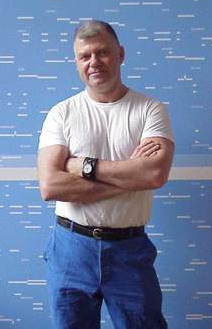Keith Milow
Keith Milow (* 1945 in London ) is an abstract painter, etcher and sculptor. He lived in New York from 1980 to 2002 and in Amsterdam from 2002 to 2014 and has lived in London since 2014.
His work has been described as architectural, monumental and (post) minimalist. In the 1970s he was one of the most famous exponents of British avant-garde art , along with Richard Long , Mark Lancaster , Tim Head , Nicholas Pope , Michael Craig-Martin , John Walker , Barry Flanagan , Gilbert & George and Derek Jarman . Very early on in his career, Milow was intrigued by the shape of the Latin cross in a non-religious way . The abstract art of the Dutch painter Piet Mondriaan had an important influence on his work . During the last decade of the 20th century, Milow worked on a series of paintings and sculptures ( 'tondi' ) that paid homage to the great artists of the 20th century. Some recent paintings and drawings are so mathematically constructed that they almost look like computer generated.
Keith Milow received his artistic training at the Camberwell School of Art (1962–1967) and at the Royal College of Art (1967–1968), both in London. In 1970 he received a Gregory Fellowship from the University of Leeds and in 1972 the important Harkness Fellowship to New York. He has received other prizes and awards from the Calouste Gulbenkian Foundation (1976), the Arts Council of Great Britain (1979), the Edward Albee Foundation (1983) and the Pollock-Krasner Foundation (2017).
Works by Keith Milow can be found in museums in the Netherlands ( Rijksmuseum Twenthe ), in Hungary ( Museum of Fine Arts Budapest ), in the USA ( Museum of Modern Art , Guggenheim Museum , Walker Art Center , Dallas Museum of Art , Denver Art Museum ), in Great Britain ( Tate Gallery , Henry Moore Foundation , Leeds City Art Gallery ) and Australia ( National Gallery of Australia , Art Gallery of South Australia ).
Web links
| personal data | |
|---|---|
| SURNAME | Milow, Keith |
| BRIEF DESCRIPTION | British abstract painter, etcher and sculptor |
| DATE OF BIRTH | 1945 |
| PLACE OF BIRTH | London |




